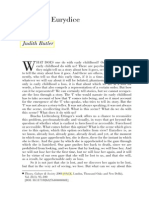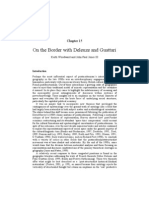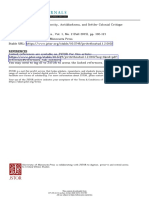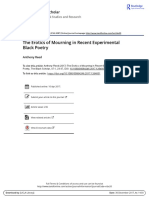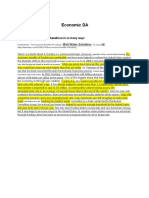0 ratings0% found this document useful (0 votes)
276 viewsDisidentification Intro Notes
Munoz engages in disidentification throughout his book by:
1) Analyzing disidentification as a survival strategy and process of self-creation used by queer people of color.
2) Exploring how disidentification works by centering queer and minority spectators, imagining alternative lives and worlds, and creating counterpublic spaces that contest dominance and allow for agency.
3) Examining how public performances of disidentification are important strategies for survival in the public sphere and creating queer counterpublics.
Uploaded by
Alonso Pierre PenaCopyright
© © All Rights Reserved
Available Formats
Download as DOCX, PDF, TXT or read online on Scribd
0 ratings0% found this document useful (0 votes)
276 viewsDisidentification Intro Notes
Munoz engages in disidentification throughout his book by:
1) Analyzing disidentification as a survival strategy and process of self-creation used by queer people of color.
2) Exploring how disidentification works by centering queer and minority spectators, imagining alternative lives and worlds, and creating counterpublic spaces that contest dominance and allow for agency.
3) Examining how public performances of disidentification are important strategies for survival in the public sphere and creating queer counterpublics.
Uploaded by
Alonso Pierre PenaCopyright
© © All Rights Reserved
Available Formats
Download as DOCX, PDF, TXT or read online on Scribd
You are on page 1/ 2
How does munoz engage in disidentification throughout his book?
- Culture as theory
- Queer of color
- Engagement with theoretical concepts which have been historically toxic for queers of color (ie
psychoanalysis, queer theory, feminist studies, etc)
Performing Disidentifications
What is disidentification?
- Disidentification is a survival strategy and a process of self-creation. (p. 4)
- Disidentification is also a hermeneutic or an optic (p. 5)
- Munoz argues that disidentification is not always the best for all situations, what kind of
disidentification does Munoz argue for? (p. 5)
o But for some, disidentification is a survival strategy that works within and outside the
dominant public sphere simultaneously
What does disidentification do? (p. 1)
- 1. Centers the queer or color as spectator
- 2. Imagines queer worlds and lives as complex
- 3. Creates counterpublics which contest hegemony, create space for minoritarian subjects to
situate self in history, and creates agency
Why is public performance important to disidentification? (p. 1)
- Public = a site of violence, therefore performance of disidentification is a strategy for survival in
public sphere and create queer counterpublics.
Margas Closet (p. 3)
- What does Marga disidentify with?
- Why is her performance disidentification? Or, how does Morgas performance disidentify?
Identity debate
- Why is identity a site of struggle? How so specifically in relation to healthcare?
o Why are disidentifying subjects unable to fully identify? (p. 7)
- Essentialism there are essential identities (p.6)
- Constructivism identity is socially constructed (p. 6)
- Munoz explains that identity is made somewhere in between:
o I understand the labor (and it is often, if not always, work) of making identity as a
process that takes place at the point of collicion of perspectives that some critics and
theorists have understood as essentialism and constructivism . . . the version of identity
politics that this book participates in imagines a reconstructed narrative of identity
formations that locates the enacting of self at precisely the point where the discourses
of essentialism and constructivism short-circuit. (p. 6)
- Identities in different, disidentities, emerge from a failed interpellation within the dominant
public sphere (p. 7)
- Identities are not memisis, but negotiated (p. 8)
You might also like
- Hourglass Workout Program by Luisagiuliet 276% (21)Hourglass Workout Program by Luisagiuliet 251 pages
- The Hold Me Tight Workbook - Dr. Sue Johnson100% (16)The Hold Me Tight Workbook - Dr. Sue Johnson187 pages
- Read People Like A Book by Patrick King-Edited62% (66)Read People Like A Book by Patrick King-Edited12 pages
- Livingood, Blake - Livingood Daily Your 21-Day Guide To Experience Real Health77% (13)Livingood, Blake - Livingood Daily Your 21-Day Guide To Experience Real Health260 pages
- COSMIC CONSCIOUSNESS OF HUMANITY - PROBLEMS OF NEW COSMOGONY (V.P.Kaznacheev,. Л. V. Trofimov.)94% (212)COSMIC CONSCIOUSNESS OF HUMANITY - PROBLEMS OF NEW COSMOGONY (V.P.Kaznacheev,. Л. V. Trofimov.)212 pages
- Donald Trump & Jeffrey Epstein Rape Lawsuit and Affidavits83% (1016)Donald Trump & Jeffrey Epstein Rape Lawsuit and Affidavits13 pages
- The 36 Questions That Lead To Love - The New York Times94% (34)The 36 Questions That Lead To Love - The New York Times3 pages
- The 36 Questions That Lead To Love - The New York Times95% (21)The 36 Questions That Lead To Love - The New York Times3 pages
- Jeffrey Epstein39s Little Black Book Unredacted PDF75% (12)Jeffrey Epstein39s Little Black Book Unredacted PDF95 pages
- The Tragedy of Heterosexuality by Jane Ward100% (1)The Tragedy of Heterosexuality by Jane Ward215 pages
- The 4 Hour Workweek, Expanded and Updated by Timothy Ferriss - Excerpt23% (954)The 4 Hour Workweek, Expanded and Updated by Timothy Ferriss - Excerpt38 pages
- E5 W02 R1 Feminist Perspectives On The Environment Sonalini Sapra 2012No ratings yetE5 W02 R1 Feminist Perspectives On The Environment Sonalini Sapra 201222 pages
- The Pleasure of Misogyny Incels Castration and Sexual DifferenceNo ratings yetThe Pleasure of Misogyny Incels Castration and Sexual Difference14 pages
- Hannah McCann and Whitney Monaghan - Queer Theory Now - From Foundations To Futures-Macmillan International - Red Globe Press (2020)No ratings yetHannah McCann and Whitney Monaghan - Queer Theory Now - From Foundations To Futures-Macmillan International - Red Globe Press (2020)21 pages
- Beautiful Bottom, Beautiful Shame Where "Black" Meets "Queer" by Kathryn Bond StocktonNo ratings yetBeautiful Bottom, Beautiful Shame Where "Black" Meets "Queer" by Kathryn Bond Stockton267 pages
- Sara Ahmed, Lancaster University: Communities That Feel: Intensity, Difference and AttachmentNo ratings yetSara Ahmed, Lancaster University: Communities That Feel: Intensity, Difference and Attachment15 pages
- Donna V. Jones, The Racial Discourses of Life Philosophy Négritude, Vitalism, and ModernityNo ratings yetDonna V. Jones, The Racial Discourses of Life Philosophy Négritude, Vitalism, and Modernity10 pages
- Ways of Seeing, Ways of Speaking: The Integration of Rhetoric and Vision in Constructing the RealFrom EverandWays of Seeing, Ways of Speaking: The Integration of Rhetoric and Vision in Constructing the RealNo ratings yet
- Tiffany King - Black Feminism and Pessimism Abolishing Moynihans Negro FamilyNo ratings yetTiffany King - Black Feminism and Pessimism Abolishing Moynihans Negro Family21 pages
- Straube, Toxic Bodies - Ticks, Trans Bodies, and The Ethics of Response-Ability in Art and Activist WritingNo ratings yetStraube, Toxic Bodies - Ticks, Trans Bodies, and The Ethics of Response-Ability in Art and Activist Writing23 pages
- Judith Butler - Wittig's Material PracticeNo ratings yetJudith Butler - Wittig's Material Practice16 pages
- Intersectionality and The Taboo of Abstraction in Feminist Theory100% (1)Intersectionality and The Taboo of Abstraction in Feminist Theory14 pages
- Lauren Berlant Cruel Optimism Becoming EventNo ratings yetLauren Berlant Cruel Optimism Becoming Event6 pages
- On The Border With Deleuze and GuattariNo ratings yetOn The Border With Deleuze and Guattari14 pages
- Eve Kosofsky Sedgwick Epistemology of The Closet PDFNo ratings yetEve Kosofsky Sedgwick Epistemology of The Closet PDF13 pages
- Pinkwashing, Homonationalism, and Israel-Palestine - The Conceits of Queer Theory and The Politics of The OrdinaryNo ratings yetPinkwashing, Homonationalism, and Israel-Palestine - The Conceits of Queer Theory and The Politics of The Ordinary19 pages
- Teaching Post-Pornography: Cultural Studies Review Vol. 24, No. 1 March 2018No ratings yetTeaching Post-Pornography: Cultural Studies Review Vol. 24, No. 1 March 201813 pages
- Gale Researcher Guide for: With a Queer Slant: Audre Lorde, Leslie Feinberg, Samuel Delany, and Dorothy AllisonFrom EverandGale Researcher Guide for: With a Queer Slant: Audre Lorde, Leslie Feinberg, Samuel Delany, and Dorothy AllisonNo ratings yet
- Burroughs William S El Almuerzo DesnudoNo ratings yetBurroughs William S El Almuerzo Desnudo14 pages
- 4a - Katherine McKittrick, On Plantations, Prisons, and A Black Sense of PlaceNo ratings yet4a - Katherine McKittrick, On Plantations, Prisons, and A Black Sense of Place18 pages
- Complete Download (Ebook) Ecodramaturgies: Theatre, Performance and Climate Change by Lisa Woynarski ISBN 9783030558529, 9783030558536, 3030558525, 3030558533 PDF All Chapters100% (8)Complete Download (Ebook) Ecodramaturgies: Theatre, Performance and Climate Change by Lisa Woynarski ISBN 9783030558529, 9783030558536, 3030558525, 3030558533 PDF All Chapters65 pages
- Regenerations / Régénérations: Canadian Women's Writing / Écriture des femmes au CanadaFrom EverandRegenerations / Régénérations: Canadian Women's Writing / Écriture des femmes au CanadaNo ratings yet
- 9 Suleiman, The Stakes in Holocaust RepresentationNo ratings yet9 Suleiman, The Stakes in Holocaust Representation18 pages
- Being Lovingly, Knowingly Ignorant: White Feminism and Women of ColorNo ratings yetBeing Lovingly, Knowingly Ignorant: White Feminism and Women of Color19 pages
- The Erotics of Mourning in Recent Experimental Black PoetryNo ratings yetThe Erotics of Mourning in Recent Experimental Black Poetry16 pages
- 傅柯性史 03 the History of Sexuality by Michel Foucault 傅柯:性史No ratings yet傅柯性史 03 the History of Sexuality by Michel Foucault 傅柯:性史4 pages
- Vieweswaran - Histories of Feminist Ethnography.No ratings yetVieweswaran - Histories of Feminist Ethnography.32 pages
- Download Full (Ebook) Diffractive Ethnography : Social Sciences and the Ontological Turn by Jessica Smartt Gullion PhD ISBN 9781351044974, 9781351044998, 9781138486621, 9781138486638, 9781351044981, 1351044974, 1351044990, 1138486620, 1138486639 PDF All Chapters100% (10)Download Full (Ebook) Diffractive Ethnography : Social Sciences and the Ontological Turn by Jessica Smartt Gullion PhD ISBN 9781351044974, 9781351044998, 9781138486621, 9781138486638, 9781351044981, 1351044974, 1351044990, 1138486620, 1138486639 PDF All Chapters81 pages
- NYONGO - Opacity, Narration, and "The Fathomless Word"No ratings yetNYONGO - Opacity, Narration, and "The Fathomless Word"12 pages
- Su, Writing The Melancholic, Kristeva's Black SunNo ratings yetSu, Writing The Melancholic, Kristeva's Black Sun29 pages
- Struggle To Be The Sun Again Introducing Asian Womens Theology Chung Hyun Kyung Z LibraryNo ratings yetStruggle To Be The Sun Again Introducing Asian Womens Theology Chung Hyun Kyung Z Library169 pages
- Gender and Colonialism A Psychological AnalysisNo ratings yetGender and Colonialism A Psychological Analysis5 pages
- The Crisis of Identity in High ModernityNo ratings yetThe Crisis of Identity in High Modernity18 pages
- "Love As The Practice of Freedom": Outlaw Culture: Resisting Representations (1994), Hooks Advocates A "ProgressiveNo ratings yet"Love As The Practice of Freedom": Outlaw Culture: Resisting Representations (1994), Hooks Advocates A "Progressive6 pages
- Elizabeth Heger Boyle-Female Genital Cutting - Cultural Conflict in The Global Community - The Johns Hopkins University Press (2002)No ratings yetElizabeth Heger Boyle-Female Genital Cutting - Cultural Conflict in The Global Community - The Johns Hopkins University Press (2002)206 pages
- Irigaray - When Our Lips Speak Together-2No ratings yetIrigaray - When Our Lips Speak Together-212 pages
- Embodiment: A Conceptual Glossary For EpidemiologyNo ratings yetEmbodiment: A Conceptual Glossary For Epidemiology6 pages
- The Biopolitics of Catastrophe, or How To Avert The Past and Regulate The Future - Frederic NeyratNo ratings yetThe Biopolitics of Catastrophe, or How To Avert The Past and Regulate The Future - Frederic Neyrat20 pages
- Ellen Rooney and Elizabeth Weed D I F F e R e N C e S in The Shadows of The Digital HumanitiesNo ratings yetEllen Rooney and Elizabeth Weed D I F F e R e N C e S in The Shadows of The Digital Humanities173 pages
- Listen to Ngarrindjeri Women Speaking: Kungun Ngarrindjeri Miminar YunnanFrom EverandListen to Ngarrindjeri Women Speaking: Kungun Ngarrindjeri Miminar Yunnan4/5 (1)
- Water Infrastructure Aff - Michigan7 2021No ratings yetWater Infrastructure Aff - Michigan7 2021250 pages
- Review of Living A Feminist Life by Sara AhmedNo ratings yetReview of Living A Feminist Life by Sara Ahmed3 pages
- "I" Pronouns: Humanizing Decolonial Gender Relations: Alonso PeñaNo ratings yet"I" Pronouns: Humanizing Decolonial Gender Relations: Alonso Peña10 pages
- Factors Affecting Project Implementation Amongst100% (2)Factors Affecting Project Implementation Amongst48 pages
- SSTORY OConnor, Flannery The Lame Shall Enter First (1962) Analysis by 5 Critics PDFNo ratings yetSSTORY OConnor, Flannery The Lame Shall Enter First (1962) Analysis by 5 Critics PDF13 pages
- Community Conversations Immigration ToolkitNo ratings yetCommunity Conversations Immigration Toolkit10 pages
- George Dickie, Breadsley Phantom Aesthetic ExperienceNo ratings yetGeorge Dickie, Breadsley Phantom Aesthetic Experience9 pages
- Girard P. R. - Quaternions, Clifford Algebras and Relativistic Physics (2007) PDFNo ratings yetGirard P. R. - Quaternions, Clifford Algebras and Relativistic Physics (2007) PDF176 pages
- Download Complete The Thief of Time Philosophical Essays on Procrastination 1st Edition Chrisoula Andreou PDF for All Chapters100% (7)Download Complete The Thief of Time Philosophical Essays on Procrastination 1st Edition Chrisoula Andreou PDF for All Chapters71 pages






































